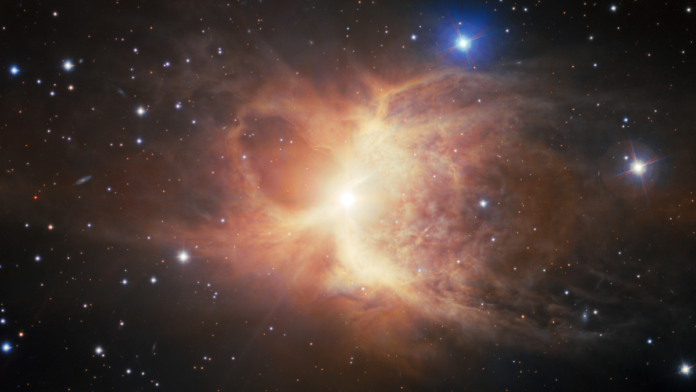The stellar wreckage left by the death throes of a giant red star takes the appearance of an overflowing cosmic jug in a stunning new image.
The observation made by the Gemini South telescope, part of the International Gemini Observatory, shows a cloud of gas and dust shed by a star as it swelled up during its red giant phase and created a rare double-lobed planetary nebula. The nebula, located around 1,200 light-years away in the direction of the constellation Carina (the Keel), may also contain the remains of a companion star to the red giant, which was shredded long ago.
In a statement accompanying the image, the International Gemini Observatory notes that the glowing orange structure is said to resemble an old English pottery drinking vessel, a Toby Jug, which takes the gnome-like form of a seated person with cartoonish features. As a result, this planetary nebula, officially designated IC 2220, is nicknamed the Toby Jug Nebula. But while its traditional jug namesakes are by design quite ugly and garish, this glorious image shows IC 2220 is anything but.
Related: Red giant stars: Facts, definition & the future of the sun
At the heart of the double-lobed Toby Jug planetary nebula is the red-giant star HR3126, which at just 50 million years old, is considerably younger than the 4.6-billion-year-old sun. HR3126 reached its red giant phase considerably more rapidly than the sun because the fact it is 5 times the mass of our star, which means it burned through its hydrogen much more rapidly than the sun does. The dying red dwarf star continues to expel gas and causes the material that surrounds it, which can take a variety of shapes, to glow brightly. This glowing envelope of gas is a planetary nebula.
Beyond its aesthetic value, this double-lobed planetary nebula is of great value to scientists studying stellar evolution. That is because this particular end-of-life phase of red giant stars is brief, and the planetary nebulas that form around them are short-lived, lasting just around 20,000 years, and are thus rarely sighted.
The somewhat rare double-lobed or bipolar structures like that of the planetary nebula illuminated by HR3126 are believed to be the result of interactions between a red giant star and a stellar companion. Previous observations of IC 2220 have failed to turn up a companion star by HR3126, however.
This absence suggests to astronomers that the companion star that once helped shape the hourglass-like form of IC 2220 has now been shredded, with its material now dispersed in the nebula.
Despite their slightly misleading name, planetary nebulas actually have nothing to do with planets. Instead, these vast clouds of gas and dust are created when stars of intermediate mass, stars slightly less massive than the sun to around 8 times the mass of our star, exhaust hydrogen at their core.
As hydrogen is the fuel for nuclear fusion, this ends the process that forges helium and ceases energy that provides an outward to support the star against the inward force of its own gravity. This results in the star’s core collapsing, but because fusion is still occurring in its outer layers, these layers do the opposite way, “puffing out” and causing the star to expand to as much as 400 times its original size.
The sun itself will enter the red giant phase in around 5 billion years, swelling out to around the orbit of Mars, swallowing the inner planets, including Earth.

